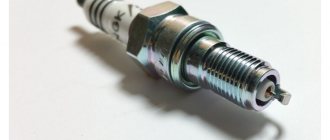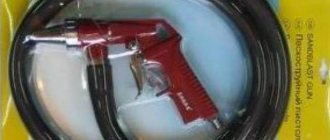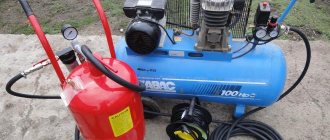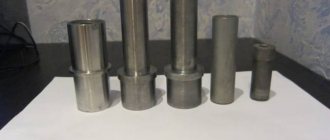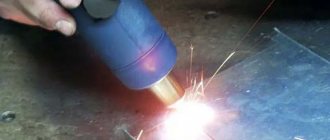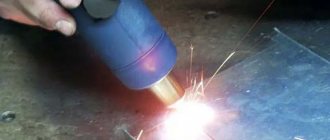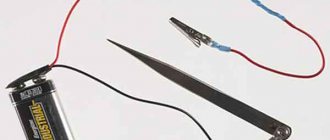The nozzle, which is used to equip a sandblasting machine, is the most important design element of such a device. Only a correctly selected nozzle will allow you to most effectively use the sandblaster for its intended purpose: to clean various surfaces from dirt, old coatings, traces of corrosion, degrease them and prepare them for further processing.
For each application, you can select a nozzle of a certain diameter, depending on the fraction of sand used
The tasks that a sandblasting nozzle solves are to compress and accelerate to the required speed a mixture consisting of air and abrasive material, as well as to form a working spot and saturate it with abrasive acting on the surface of the workpiece. Depending on the size of the surface to be sandblasted, different types of holes can be made in the nozzles. Thus, for processing narrow surfaces, nozzles with the same diameter along the entire length are used, and for cleaning large surfaces, products are used, the holes in which have larger diameters at the inlet and outlet (Venturi type, developed in the middle of the last century).
Compressor performance
The diameter of the nozzle, first of all, depends on the performance of the compressor (the number of cubic meters of compressed air per minute): the more productive the compressor, the larger the diameter of the nozzle can be used effectively (see table below). The most interesting thing: the higher the compressor performance, the less abrasive consumption will be for cleaning each square meter of the surface being treated.
If you use a nozzle that is less than optimal, there will be a loss of performance and the nozzle may become clogged more often.
If the nozzle is larger than optimal, there will be a loss of kinetic energy of the abrasive-air mixture, which also entails a drop in work productivity with a simultaneous overconsumption of abrasive material.
The pressure created by the compressor is not a determining factor and will be an important parameter if the work site is located far from the compressor, or is located much higher in level than the compressor.
The essence of sandblasting
Sandblasting involves exposing various surfaces to an abrasive material. Sand, shot, silicon carbide, small glass beads, etc. are used as the latter.
Sandblasting is a mechanical action on the surface of small solid particles
Before processing begins, the abrasive is placed in a sealed hopper. Air coming from a separate compressor is supplied through the main hose of the device under high pressure. Passing by the opening of the intake hose, the air flow creates a vacuum in it, which facilitates the suction of abrasive into the main hose. The air, already mixed with abrasive, is supplied to the gun, the main element of which is a sandblasting nozzle, through which the abrasive mixture is supplied to the surface being treated.
Layout of the sandblasting area
As mentioned above, various types of abrasives can be used to perform sandblasting. The choice here depends on the type of surface that needs to be cleaned. Thus, treatment using sand is effective in cases where it is necessary to remove a layer of old paint from a concrete surface, clean brick walls from cement residues, and prepare metal parts for further painting. Abrasives such as plastic or wheat starch are successfully used in the shipbuilding, automotive and aircraft manufacturing industries, with their help they effectively remove old coatings from composite materials.
What should you pay attention to when choosing?
Poor quality sandblasting nozzles are identified visually using the following methods:
- The color of the abrasion resistant insert made of boron carbide present should be dark graphite. Gray and the presence of light gray color indicates a product created from silicon carbide or a created mixture of different powders.
- The heavy nozzle is made of tungsten carbide, and such devices are lighter from boron and silicon.
- When making an insert from two parts, it is recommended to pay attention to their existing alignment, as well as the obligatory correspondence of the diameter. In this case, there should be no skew steps or any bends in the direction of the abrasive flow.
- The polyurethane shell of the working nozzle is rigidly fixed to the aluminum jacket.
- If there is a ring mark along the ring of the aluminum jacket, it becomes clear that the threaded part present and the durable body of the device consist of two manufactured parts. As a result, over time, the threads can be pulled out, causing injury to a person.
Particularly important is the high-quality assembly of the working nozzle of such equipment. There should be no traces of glue on such products. It is also required that the diameter of the insert strictly matches the existing diameter of the aluminum shell or the existing rubber seal.
In this case, there should be no protrusions, notches or edges that impede the passage of the abrasive flow. For high-quality Double Venturi nozzles, the alignment of the working channels before and after reaching the ejection holes is very important. If there is no alignment, the ejection effect will be absent.
Typical nozzle design
The simplest nozzle for a sandblasting machine is a hollow tube with a threaded part at one end, which is designed to connect the part to the nozzle holder.
The main geometric characteristics of industrially produced replacement nozzles:
- The diameter of the connecting thread (depends on the technical characteristics of the sandblasting machine, but a 2" or 1¼" cylindrical pipe thread is usually used. It is also possible to connect the nozzle with the nozzle holder using a union nut and a sealing washer. Do-it-yourself nozzles are connected to the hose of the working unit using ordinary clamps.
- The length of the part, which varies in the range of 7…23 mm (shorter ones are used for cleaning less contaminated surfaces).
- The diameter of the internal hole at its minimum cross-section. Replacement tips are available with diameters of 6, 8, 10 and 12 mm.
- The inlet diameter of the nozzle, determined by the diameter of the connecting hose (it can be 25 or 32 mm).
The main parameter of the part under consideration is the profile of the internal hole, which determines the flow loss of the air-sand mixture, its speed at the inlet and outlet of the nozzle, as well as the value of the total hydraulic resistance, which ultimately determines the durability of the nozzle.
The simplest option (suitable for making it yourself) is a nozzle with a cylindrical internal hole of constant diameter. But to improve aerodynamic characteristics, two conical sections are sometimes made on such parts:
- Inlet confuser, the presence of which allows you to increase the energy of the flow of the mixture entering the nozzle;
- An output diffuser, the presence of which helps to increase the surface area processed simultaneously. In this case, the flow energy decreases, therefore, if higher-quality cleaning is necessary, a diffuser profile at the end of the nozzle is not always provided.
The most efficient internal orifice profile to ensure minimal flow loss is a Venturi profile sandblaster nozzle.
In this case, the hole consists of three interconnected sections, each of which performs certain functions:
- At the inlet of a nozzle with a Venturi profile there is a confuser expansion, the angle of which, however, is less than that of a confuser of a conventional nozzle (no more than 20...22º). The confuser part occupies up to 30% of the total length of the part.
- Cylindrical part, no more than 15% long.
- A diffuser part with a fairly small expansion angle (7...15º), the length of which is determined by the size of the nozzle itself in plan.
In order to reduce the hydrodynamic resistance of the working mixture that moves in the nozzle channel, all transitions from one part to the next are made with radius curves, the value of which is taken within the range of r = (0.02...0.03) d, where d is the diameter of the middle, cylindrical part of the nozzle.
How to choose a nozzle for a sandblaster
In addition to the type of hole and diameter, the most important technical parameters of the nozzle, which directly determine its operation, are:
- length;
- manufacturing material.
The length should be selected depending on the degree of contamination of the surface to be treated. If the rust, dirt, plaque is not too thick, you can choose a short part (7–8 cm). For surfaces with difficult to remove, complex, thick layers of dirt, buy longer tubes (up to 23 cm).
To create a nozzle with your own hands, use a variety of materials and improvised devices. As for purchased products, they can also be completely different regarding the base, and the service life will vary greatly:
- ceramic – 2 hours;
- cast iron – up to 8 hours;
- tungsten – up to 300 hours;
- from boron carbide – up to 1000 hours.
The longevity of the nozzle also greatly depends on the type of abrasive material: for example, when replacing sand with steel shot, the service life increases by 2.5 times. Inexpensive products usually fail the fastest, so they are completely unsuitable for large volumes of work. For one-time household use, you can buy a ceramic or cast iron nozzle, or a set of them, to replace as needed. Professionals use tungsten or boron carbide parts, which are expensive, but are much more economical with regular use.
You should not purchase steel nozzles - ordinary carbon steel is not suitable for making nozzles for a sandblasting machine, as it is very sensitive to impact loads. Tungsten products also have their drawback: they do not tolerate heat well and can crack at temperatures of +80...+100 degrees. Parts made of boron carbide in this regard are superior to others: they can only deteriorate at +600...+750 degrees, which is unlikely during sandblasting. But their price reaches 1600–7000 rubles, so they are not very accessible to non-professionals.
Channel type of sandblasting nozzles
The nozzle channel directly affects the acceleration speed of the abrasive and air flow and the performance of the entire installation. Products with a straight-line (straight-through) channel are usually used for processing small surfaces or narrow parts. The most effective are nozzles whose diameter varies depending on the area, rather than remaining constant.
A typical representative of quality products are Venturi nozzles. They help businesses improve quality and efficiency, reduce time, labor, and cleaning costs. To use them, you do not need to change the abrasive (any one will do) or increase the compressor power.
Boron carbide nozzle GN UBC
These are the most commonly found sandblasting attachments on the market. They create a wide imprint of abrasive particles, allowing you to develop high speed and high kinetic energy. Typically used to perform a significant amount of work.
Boron carbide nozzle GN UBC XL
The length of the channel in such products is 3.5 cm, their productivity is 30–50% higher than that of the previous ones. The price of the attachments is quite high, and they cannot be used for small volumes of work due to the strong acceleration of abrasive particles.
Boron carbide nozzle GN DVBC
The Double Venturi technology uses the ejection effect - when air from the atmosphere is introduced into the abrasive flow. The diameter of the tube outlet is larger here than in the classic version, and the sand jet is supplied with maximum kinetic energy. To use such a nozzle, you need an installation with a powerful compressor, long hoses, and it is advisable to use it only on large surfaces to be treated.
Material and design of internal wear-resistant insert
As for the material for making the inside of the nozzle, it can be inexpensive but short-lived, or higher quality but expensive. The most popular for this purpose are boron, tungsten and silicon carbides. Due to the difference in processing technologies for these materials, nozzle designs can differ greatly from each other (for example, it is impossible to make a cylinder more than 7 cm long from boron carbide, which determines the design features of the nozzles - they have to be made of several elements). The wall thickness of the internal bushings also varies from 3 to 6 mm, which affects the resistance to abrasive action.
Containment design and nozzle build quality
The product shell is needed to fix the wear-resistant sleeve and protect it from rapid damage. It is the shell that bears most of the impact loads, so it is more susceptible to wear. In order for the nozzle to have sufficient service life, the protection must be made of abrasion-resistant material, be tightly attached to the sleeve, and have a reliable thread.
There are these types of shells:
- Polyurethane. Lightweight, resistant to damage by abrasives, but due to its low rigidity, its thread wears out quite quickly. Due to poor adhesion of polyurethane to the main materials for making bushings, the latter begin to move, air penetrates between them, and the protective shell deteriorates.
- Metal (steel, aluminum). Reliably attaches wear-resistant bushings, but its resistance to abrasive action is low. The shell suffers from corrosion and is too heavy in weight. A structure with such a part will be rigid, but can quickly become damaged.
- Combined (aluminum plus polyurethane). It is considered the most popular option; it is rigid but lightweight, and has a coarse pitch thread. Polyurethane in the front part protects the product from abrasive wear. It is only important to firmly fix the shell inside the sleeve, otherwise the nozzle will begin to collapse.
Build quality also plays an important role in the service life of the entire structure. There are low-quality nozzles on sale, where the body and the threaded part are pressed into each other. Most often, they quickly deteriorate, and at a pressure above 8–10 bar, they can even cause injury to a person or breakdown of the entire sandblasting machine. The most loaded part of the nozzle must be machined from a solid piece, otherwise the threaded area will tear out during operation.
Advantages and disadvantages
Sandblasting equipment allows you to quickly clean the surface of various contaminants and outdated finishes:
- dirt;
- oil;
- scale;
- fat;
- dye;
- primer;
- putty.
It takes several times less time to prepare a part for further processing and painting than using detergents and solvents.
Sand is easy to obtain. If used continuously, it can be used several times. It must be sifted and calcined.
The air flow with sand and other abrasives penetrates narrow cracks and small holes. The cleaning speed does not depend on the complexity of the design.
Sandblasting machines have a simple design. It is enough to connect the compressor and a container with sand with hoses.
Disadvantages include operating equipment under high pressure. If a hose ruptures or enters the work area, a person may be seriously injured.
The attachments wear out quickly. A metal nozzle made of abrasion-resistant steel is enough for 1 – 2 hours of operation.
Operating principles
A lot depends on the nozzle: the quality and the processing process itself, the consumption of air and sand. This element can be made of different materials, which affects its durability. Cheap elements are designed to last several tens of hours, but it happens that they are destroyed after just an hour of operation. This applies to ceramic and cast iron parts. Tungsten carbide nozzles can last up to 1000 hours of operation. But they are relatively expensive.
How to make it yourself?
The service life of a homemade nozzle is short, but its cost will be minimal. To make the part, a car spark plug or an old ceramic resistor is suitable. The internal diameter should be 2-4 mm.
To make a nozzle from a resistor, you need:
- Cut off the caps and stems.
- Take an M14 bolt. It is necessary to cut off the top, and then drill the hole through with a No. 5 drill.
- Extend the first 14 mm with a No. 8 drill.
- A wide M5 washer is welded onto the clamping nut.
- Using a No. 8 drill, a cone is made.
To make a spark plug you need:
- Remove the contact plug. To do this, it is better to first warm the candle with a gas burner.
- Remove the rolled part.
- Remove the ceramic insulator.
- Remove the nut. It's better to cut its edges first.
- Using a grinder with a diamond blade, cut off the part where the central electrode is located.
- Connect the adapter with the clamping nut. You need to buy it or grind it yourself in advance.
If sandblasting is used regularly, it is better to buy a ready-made high-quality part. There are various nozzles on sale with high performance and long service life.
